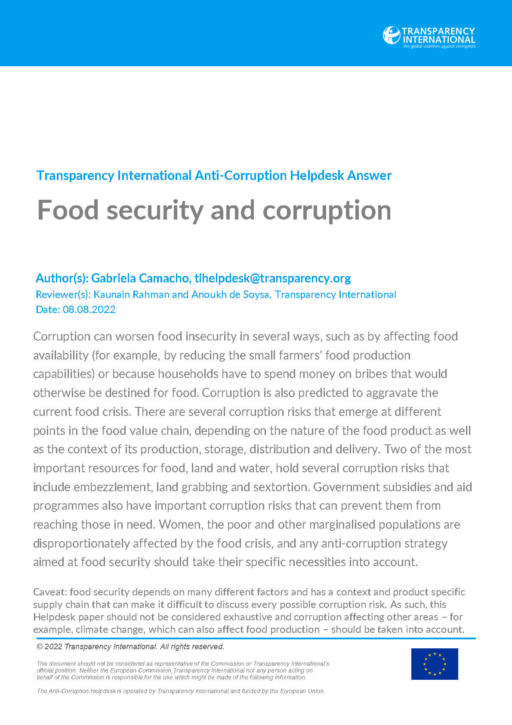
This Anti-Corruption Helpdesk brief was produced in response to a query from one of Transparency International’s national chapters. The Anti-Corruption Helpdesk is operated by Transparency International and funded by the European Union.
Query
Could you please provide an overview on how corruption can affect food security?
Summary
Corruption can worsen food insecurity in several ways, such as by affecting food availability (for example, by reducing the small farmers’ food production capabilities) or because households have to spend money on bribes that would otherwise be destined for food. Corruption is also predicted to aggravate the current food crisis. There are several corruption risks that emerge at different points in the food value chain, depending on the nature of the food product as well as the context of its production, storage, distribution and delivery. Two of the most important resources for food, land and water, hold several corruption risks that include embezzlement, land grabbing and sextortion. Government subsidies and aid programmes also have important corruption risks that can prevent them from reaching those in need. Women, the poor and other marginalised populations are disproportionately affected by the food crisis, and any anti-corruption strategy aimed at food security should take their specific necessities into account.
Contents
1. Background
- Food security
- Role of corruption in the current food crisis
2. Corruption and food security
3. Corruption risks in different food sectors and along the value chain
- Corruption in food production: Agriculture, Cattle and Poultry, and Fishery
- Corruption in food storage and certification
- Corruption in food supply and distribution
- Corruption at the point of delivery
- The whole value chain
4. Corruption and food security resources
- Land
- Water
5. Curbing corruption in food security
Main points
- Food security is a concept with several dimensions, covering not only food availability but also its access and use. The drivers behind food insecurity are not limited to a lack of food production but include other factors, such as poor distribution.
- Different corruption risks emerge in different food sectors and along different stages of the value chain. Any strategy to curb corruption has to take into account these particularities.
- Corruption in land and water use can endanger reliable food production and benefit large conglomerates instead of small-scale farmers who produce much of the world’s food but are themselves food insecure. Securing land tenure, addressing land concentration and curbing corruption in irrigation systems are key.
Caveat
Food security depends on many different factors and has a context and product specific supply chain that can make it difficult to discuss every possible corruption risk. As such, this Helpdesk paper should not be considered exhaustive and corruption affecting other areas – for example, climate change, which can also affect food production – should be taken into account.
Authors
Gabriela Camacho, [email protected]
Reviewers
Kaunain Rahman and Anoukh de Soysa, Transparency International
Date
14/09/2022

